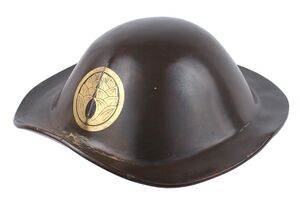Helmet: Difference between revisions
1d4chan>A Walrus No edit summary |
1d4chan>A Walrus No edit summary |
||
| Line 24: | Line 24: | ||
*Kettle Hat: A steel dome with a wide brim around it. | *Kettle Hat: A steel dome with a wide brim around it. | ||
*Chainmail Hood: To better protect people's heads, they often wore hoods made of chainmail. This practice was common across Europe, the middle east and asia. | *Chainmail Hood: To better protect people's heads, they often wore hoods made of chainmail. This practice was common across Europe, the middle east and asia. | ||
*Greathelm: A steel bucket with eyeholes wore by knights. | *Greathelm: A steel [[bucket]] with eyeholes wore by knights. | ||
*Kanabo: Japanese Samurai helmets, have a dome part as well as a back made of laminar protecting the neck and cheeks. For facial protection they had a mempo, a stylized mask. | *Kanabo: Japanese [[Samurai]] helmets, have a dome part as well as a back made of laminar protecting the neck and cheeks. For facial protection they had a mempo, a stylized mask. | ||
*Jingasa: Ashigaru Helmet, these were usually cone shaped (though latter ones bore a resemblance to Morions and kettle hats) and made of steel or lacquered wood. | *Jingasa: Ashigaru Helmet, these were usually cone shaped (though latter ones bore a resemblance to Morions and kettle hats) and made of steel or lacquered wood. | ||
== Helmets and Faces == | == Helmets and Faces == | ||
Revision as of 19:22, 2 November 2013

A Helmet is a variety of hat which is designed to protect the wearer's head not just from cold and wetness, but also from external damage from blows.
Reasons for wearing a Helmet
- Sport Safety (Hockey, American Football, Bicycling)
- Workplace Safety
- Extra Vehicular Activity
- Hazmat Work
- Entering a Combat Situation
Materials to make a helmet out of
- Wood, if you have trees but metal is scarce or you are really primitive
- Wool, if you have sheep but metal is scarce or you are really primitive, this applies to other textiles as well
- Leather, if you have large animals but metal is scarce, you are really primitive or are at the bottom of the social ladder
- Bronze, if you are living in the bronze age
- Steel, if your society has mastered iron working and does not want to put up with importing tin and/or copper
- Plastics
- Ceramics and ballistic textiles, if you are in the modern age and want to stop shrapnel and pistol rounds out of your brain
- Tinfoil, to keep out the FBI/CIA/NSA/MI6/CSIS/Russian/European Union/Chinese/Indian/Templar/Google/Scientologist/Vatican/Wold Bank/NWO/MIB/Moon Nazi/Mars Soviet/Mercury Empire of Japan/Asteroid Belt Napoleonic Empire/Lizard Men/Pinniped mind control rays.
Some types of helmets
- Corinthian: Ancient Greek Hoplite Helmet, made of bronze, a single piece affair with built in cheek guards and nose guard (known as a nasal). Often had a horse hair/plumed crest.
- Galea: The Helmet worn by Roman legionaries, made out of several pieces of bronze or steel. Had cheek guards on hinges and a back guard to protect the neck.
- Spangenhelm: A dark age (5th to 9th century) helmet made of bits of iron forged riveted onto a frame. An easier form to forge than an iron bowl for unskilled smiths. Sometimes had a nasal or cheek guards attached.
- Cervelliere: A dark age/medieval helmet composed of a single steel dome with maybe a nasal.
- Kettle Hat: A steel dome with a wide brim around it.
- Chainmail Hood: To better protect people's heads, they often wore hoods made of chainmail. This practice was common across Europe, the middle east and asia.
- Greathelm: A steel bucket with eyeholes wore by knights.
- Kanabo: Japanese Samurai helmets, have a dome part as well as a back made of laminar protecting the neck and cheeks. For facial protection they had a mempo, a stylized mask.
- Jingasa: Ashigaru Helmet, these were usually cone shaped (though latter ones bore a resemblance to Morions and kettle hats) and made of steel or lacquered wood.
Helmets and Faces
Helmets are the most common type of combat armor employed in History. Helmets protect your brain, your most important organ, from damage. When compared to a breastplate or other such article of torso armor, fairly small and inexpensive to make. If you had to have just one bit of armor, you got a helmet. Helmets came in many shapes and sizes. On thing which could often be said was that covering as much as possible of the head often made a helmet, with a few small holes to look and breathe out of is better at it's job than its more skimpy counterparts.
However, for visual fiction these helmets can be problematic as they hide the faces of the character and as such, limit what emotion can be shown to the audience, as well as concealing his his/her identity and making them less relatable, ironically serving the opposite function of all other varieties of hats. For this reason, full head helmets are usually reserved for faceless enemies employed by the enemy to be killed with a minimum of audience empathy while heroes wear helmets which leave their faces exposed, or simply go helmetless into combat situations.